Measuring Ultrasonic and Electrical Properties of Early-Age Cemented Tailings Backfill
Abstract
:1. Introduction
2. Materials and Sample Preparation
2.1. Materials
2.2. Sample Preparation and Mix Proportion
2.3. Experimental Measurement Methods
2.3.1. Electrical Conductivity Measurement
2.3.2. Hydration Heat Measurement
2.3.3. Ultrasonic Pulse Measurement
2.4. Ultrasonic Signal Processing
3. Experimental Results
3.1. Ultrasonic Pulse Evolution over Curing Time
3.2. Electrical Conductivity Evolution over Curing Time
3.3. Hydration Heat and Initial Set
3.4. Discussions
3.4.1. Relationship between TG and Rate of Heat Production
3.4.2. Relationship between TG and UPV
3.4.3. Setting Model of Cemented Tailings Backfill
4. Conclusions
- According to the early ultrasonic waveform changes, the early hydration process of the CTB samples can be divided into three stages: the liquid propagation stage with low frequency as the dominant frequency, the transitional stage and the solid propagation stage with high frequency as the dominant frequency.
- The active mineral components in tailings (e.g., CaO and MgO) will promote cement hydration and shorten the induction stage.
- For the cemented silica tailings backfill, the initial set time is 396, 475 and 503 min with the cement content of 2.5%, 5% and 7.5%, respectively, while for the cemented iron tailings backfill, the initial set time increases to 602, 710 and 960 min with the cement content of 2.5%, 5% and 7.5%, respectively. The fine iron tailings greatly delay the arrival of the initial set time.
- Based on the changes in the ultrasonic amplitude and EC values, the solid connection and liquid channel closure of the early-age CTB can be obtained, respectively.
- The TG value can effectively reflect the early-age hydration process and determine the initial set time of cemented silica tailings backfill. Meanwhile, for cemented iron mine tailings, further research is needed.
Author Contributions
Funding
Conflicts of Interest
References
- Li, J.; Cao, S.; Yilmaz, E. Compressive fatigue behavior and failure evolution of additive fiber-reinforced cemented tailings composites. Int. J. Miner. Metall. Mater. 2022, 29, 2351. [Google Scholar] [CrossRef]
- Li, J.; Cao, S.; Yilmaz, E. Characterization of Macro Mechanical Properties and Microstructures of Cement-Based Composites Prepared from Fly Ash, Gypsum and Steel Slag. Minerals 2022, 12, 6. [Google Scholar] [CrossRef]
- Rybak, J.; Kongar-Syuryun, C.; Tyulyaeva, Y.; Khayrutdinov, A.M. Creation of Backfill Materials Based on Industrial Waste. Minerals 2021, 11, 739. [Google Scholar] [CrossRef]
- Ylmén, R.; Jäglid, U.; Steenari, B.M.; Panas, I. Early hydration and setting of Portland cement monitored by IR, SEM and Vicat techniques. Cem. Concr. Res. 2009, 39, 433–439. [Google Scholar] [CrossRef]
- Wang, L.G.; Ju, S.Y.; Chu, H.Y.; Liu, Z.Y.; Jiang, J.Y. Hydration process and microstructure evolution of low exothermic concrete produced with urea. Constr. Build. Mater. 2020, 248, 118640. [Google Scholar] [CrossRef]
- Brameshuber, W.; Brockmann, T. Electrical conductivity measurements to characterize the setting and hardening of mortars. J. Nondestruct. Test. 2003, 8, 16–19. [Google Scholar]
- Tamás, F.D.; Farkas, E.; Vörös, M.; Roy, D.M. Low-frequency electrical conductivity of cement, clinker and clinker mineral pastes. Cem. Concr. Res. 1987, 17, 340–348. [Google Scholar] [CrossRef]
- Wei, X.S. Interpretation of Hydration Process of Cement-Based Materials Using Electrical Resistivity Measurement. Ph.D. Thesis, Hong Kong University of Science and Technology, Hong Kong, China, 2004. [Google Scholar]
- Xu, W.B.; Zhang, Y.L.; Zuo, X.H.; Hong, M. Time-dependent rheological and mechanical properties of silica fume modified cemented tailings backfill in low temperature environment. Cem. Concr. Compos. 2020, 114, 103804. [Google Scholar] [CrossRef]
- Sallehi, H.; Ghods, P.; Isgor, O.B. Formation factor of fresh cementitious pastes. Cem. Concr. Compos. 2018, 91, 174–188. [Google Scholar] [CrossRef]
- Carette, J.; Staquet, S. Monitoring the setting process of s by ultrasonic P-wave and S-wave transmission velocity measurement. Constr. Build. Mater. 2015, 94, 196–208. [Google Scholar] [CrossRef]
- Zhang, J.; Weissinger, E.A.; Peethamparan, S.; Scherer, G. Early hydration and setting of oil well cement. Cem. Concr. Res. 2010, 40, 1023–1033. [Google Scholar] [CrossRef]
- Xu, X.; Sun, X.; Yao, W.; Wu, P.; Qiu, J.; Guo, Z.; Liu, N. Strength and ultrasonic characteristics of cemented paste backfill incorporating foaming agent. Minerals 2021, 11, 681. [Google Scholar] [CrossRef]
- Ylmaz, T.; Ercikdi, B. Predicting the uniaxial compressive strength of cemented paste backfill from ultrasonic pulse velocity test. Nondestruct. Test. Eval. 2015, 31, 247–266. [Google Scholar] [CrossRef]
- Lee, H.K.; Lee, K.M.; Kim, Y.H.; Yim, H. Ultrasonic in-situ monitoring of setting process of high-performance concrete. Cem. Concr. Res. 2004, 34, 631–640. [Google Scholar] [CrossRef]
- Tian, X.; Xu, W. Prediction of the mechanical performance of cemented tailings backfill using ultrasonic pulse velocity measurement. Minerals 2022, 12, 986. [Google Scholar] [CrossRef]
- Robeyst, N.; Gruyaert, E.; Belie, N.D. Ultrasonic monitoring of setting and hardening behaviour of concrete and with blast-furnace slag cement. In Proceedings of the 12th International Congress on the Chemistry of Cement (ICCC 2007), Montréal, QC, Canada, 8–13 July 2007. [Google Scholar]
- Yan, B.; Zhu, W.; Hou, C.; Yilmaz, E.; Saadatc, M. Characterization of early age behavior of cemented paste backfill through the magnitude and frequency spectrum of ultrasonic P-wave. Constr. Build. Mater. 2020, 249, 118733. [Google Scholar] [CrossRef]
- Huang, C.; He, W.; Lu, B.; Wang, M. Study on acoustic emission and coda wave characteristics of layered cemented tailings backfill under uniaxial compression. Minerals 2022, 12, 896. [Google Scholar] [CrossRef]
- Robeyst, N.; Christian, U.; Grosse, C.U. Measuring the change in ultrasonic p-wave energy transmitted in fresh with additives to monitor the setting. Cem. Concr. Res. 2009, 39, 868–875. [Google Scholar] [CrossRef]
- Gams, M.; Trtnik, G. A new US procedure to determine setting period of cement pastes, s, and concretes. Cem. Concr. Res. 2013, 53, 9–17. [Google Scholar] [CrossRef]
- Trtnik, G.; Gams, M. The use of frequency spectrum of ultrasonic P-waves to monitor the setting process of cement pastes. Cem. Concr. Res. 2013, 43, 1–11. [Google Scholar] [CrossRef]
- Ghirian, A.; Fall, M. Coupled thermo-hydro-mechanical-chemical behavior of cemented paste backfill in column experiments. Part I: Physical, hydraulic and thermal processes and characteristics. Eng. Geol. 2013, 170, 11–23. [Google Scholar] [CrossRef]
- Koleva, D.; Copuroglu, O.; Breugel, K.; Ye, G.; Dewit, J.H.W. Electrical resistivity and microstructural properties of concrete materials in conditions of current flow. Cem. Concr. Compos. 2008, 30, 731–744. [Google Scholar] [CrossRef]
- Courard, L.; Michel, F.; Perkowicz, S.; Garbacz, A. Effects of limestone fillers on surface free energy and electrical conductivity of the interstitial liquid of cement mixes. Cem. Concr. Compos. 2014, 45, 111–116. [Google Scholar] [CrossRef] [Green Version]
- Duhamel, P.; Vetterli, M. Fast fourier transforms: A tutorial review and a state of the art. Signal Process. 1990, 19, 259–299. [Google Scholar] [CrossRef] [Green Version]
- Nelson, P.V.; Povey, M.; Wang, Y. An ultrasound velocity and attenuation scanner for viewing the temporal evolution of a dispersed phase in fluids. Rev. Sci. Instrum. 2001, 72, 4234–4241. [Google Scholar] [CrossRef]
- Challis, R.; Povey, M.; Mather, M.; Holmes, A. Ultrasound techniques for characterizing colloidal dispersions. Rep. Prog. Phys. 2005, 68, 1541–1550. [Google Scholar] [CrossRef]
- Feylessoufi, A.; Tenoudji, F.C.; Morin, V.; Richard, P. Early ages shrinkage mechanisms of ultra-high-performance cement-based materials. Cem. Concr. Res. 2001, 31, 1573–1579. [Google Scholar] [CrossRef]
- Sayers, C.; Dahlin, A. Propagation of ultrasound through hydrating cement pastes at early times. Adv. Cem. Based Mater. 1993, 1, 12–21. [Google Scholar] [CrossRef]
- Ye, G.; Breugel, K.; Fraaij, A. Experimental study and numerical simulation on the formation of microstructure in cementitious materials at early age. Cem. Concr. Res. 2003, 33, 233–239. [Google Scholar] [CrossRef]
- Paglia, C.; Wombacher, F.; Bhni, H. The influence of alkali-free and alkaline shotcrete accelerators within cement systems: I. Characterization of the setting behavior. Cem. Concr. Res. 2001, 31, 913–918. [Google Scholar] [CrossRef]
- Punurai, W.; Jarzynski, J.; Qu, J.; Kim, J.E. Characterization of multi-scale porosity in cement paste by advanced ultrasonic techniques. Cem. Concr. Res. 2007, 37, 38–46. [Google Scholar] [CrossRef]
- Jupe, A.; Wilkinson, A.; Funkhouser, G. Simultaneous study of mechanical property development and early hydration chemistry in Portland cement slurries using X-ray diffraction and ultrasound reflection. Cem. Concr. Res. 2012, 42, 1166–1173. [Google Scholar] [CrossRef]
- Schutter, G.D.; Taerwe, L. General hydration model for Portland cement and blast furnace slag cement. Cem. Concr. Res. 1995, 25, 593–604. [Google Scholar] [CrossRef]

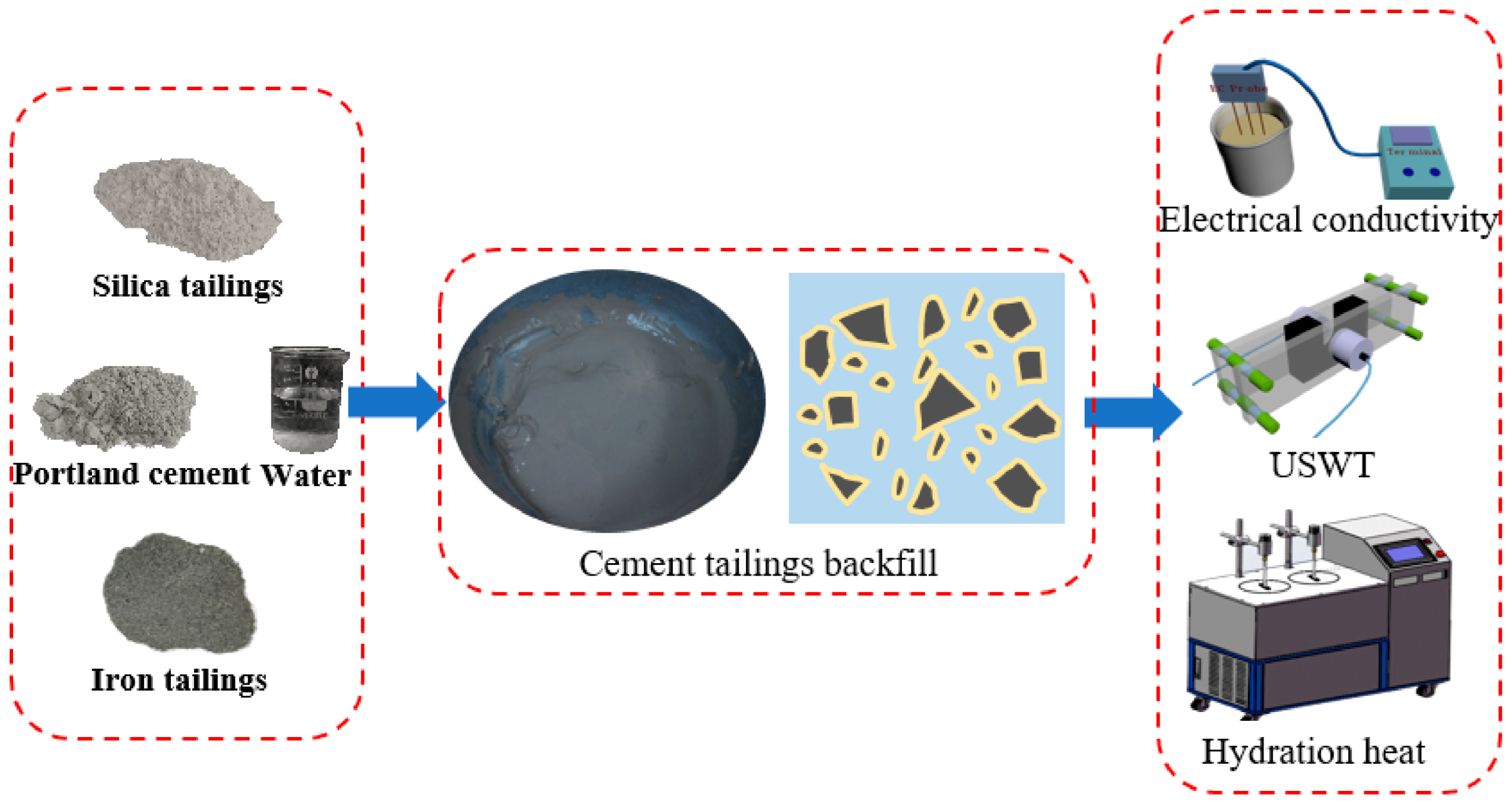
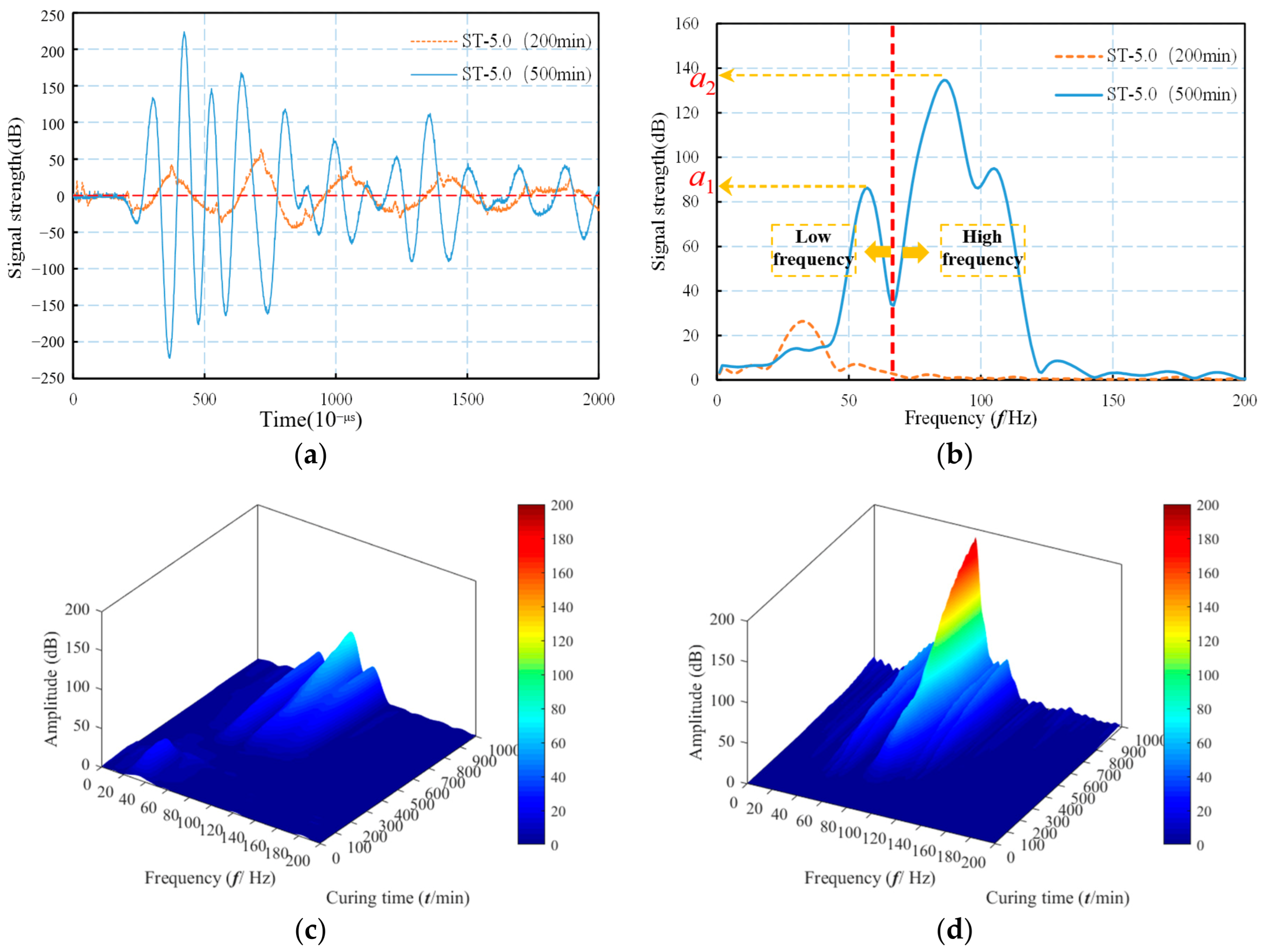
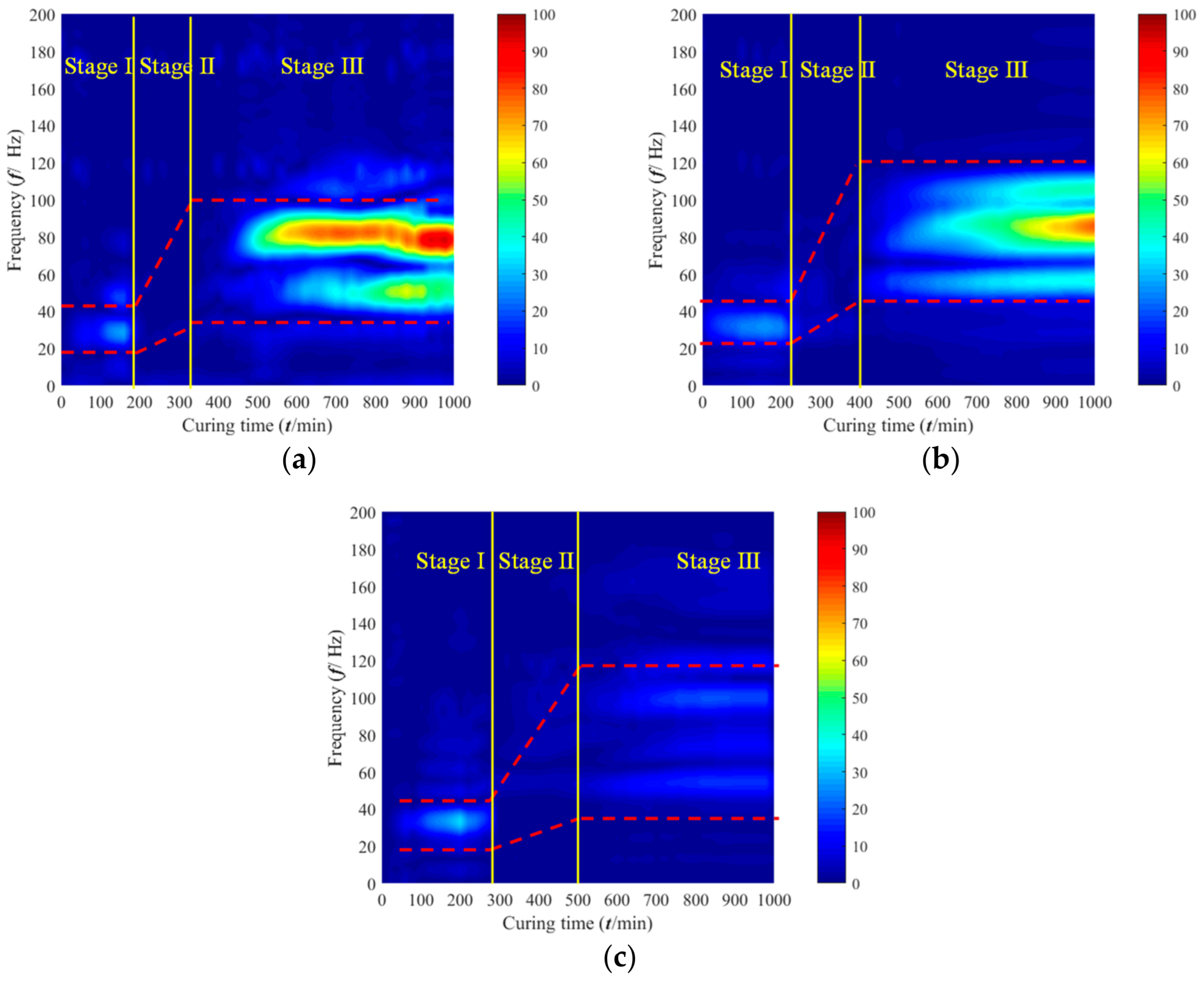
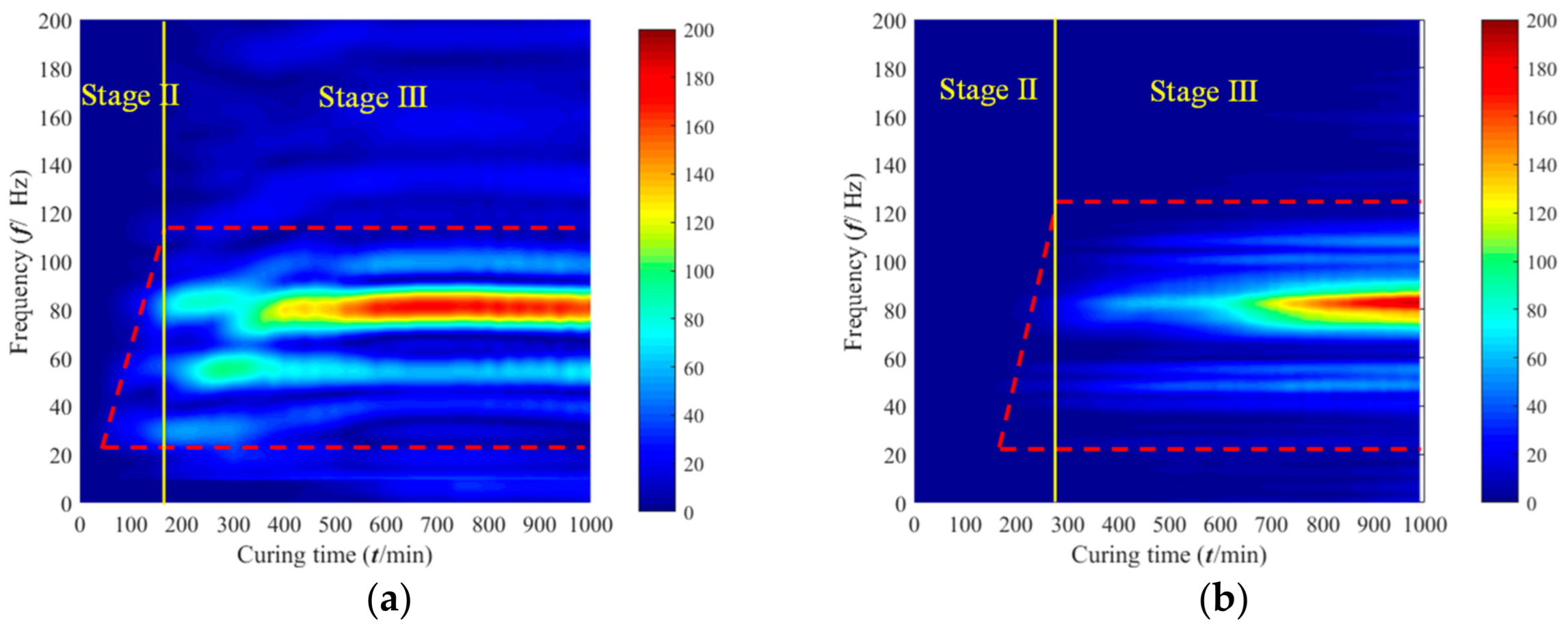
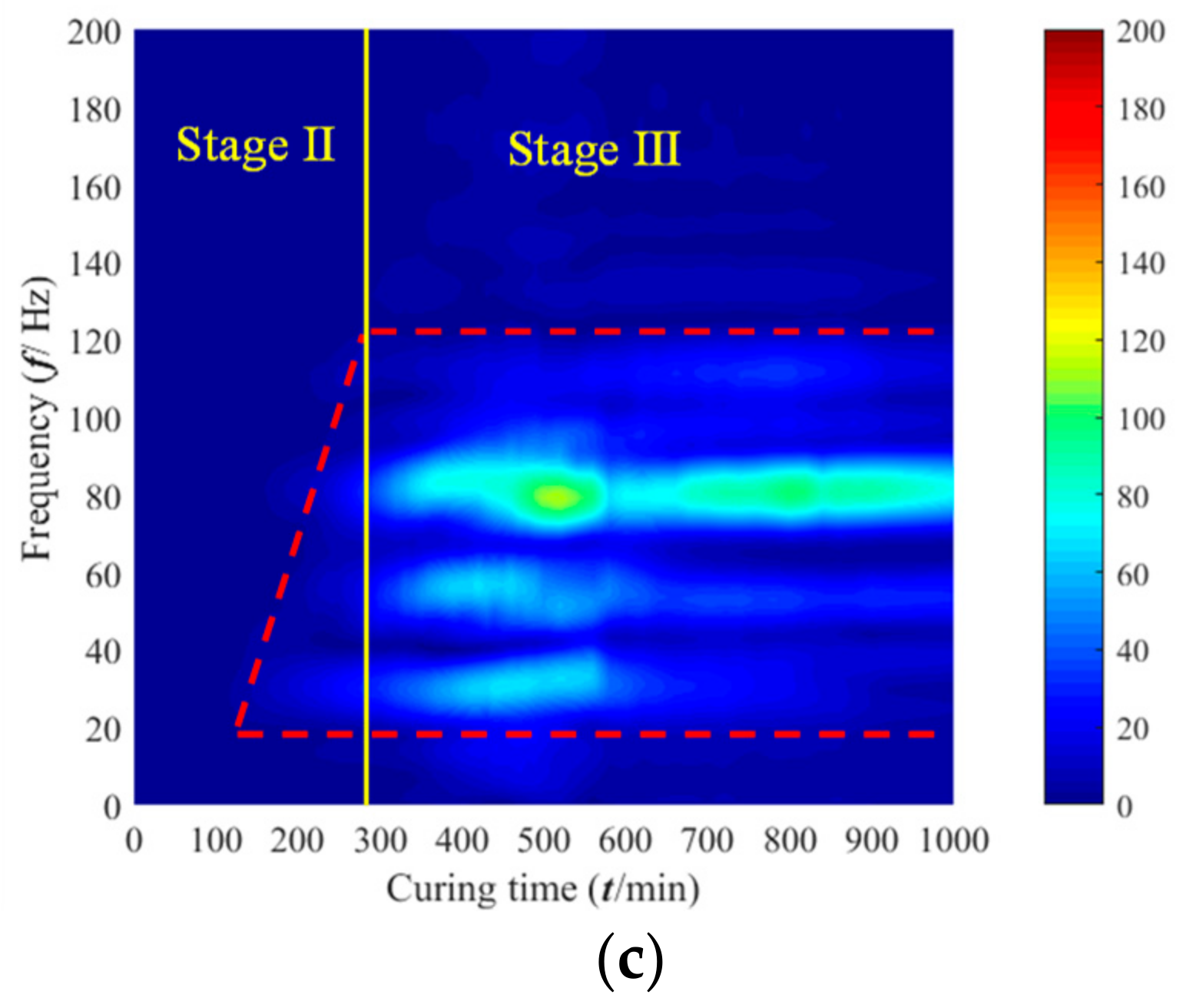
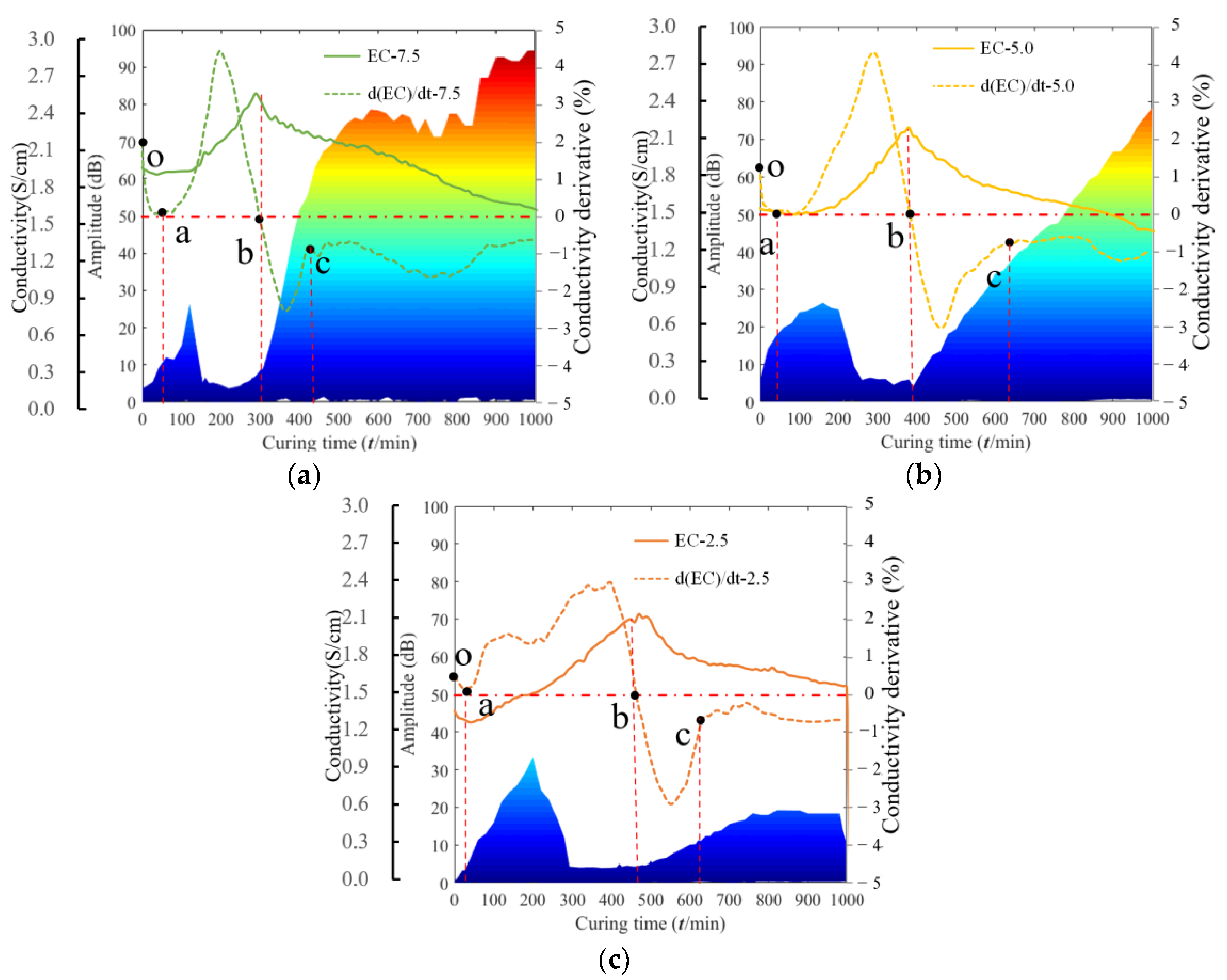
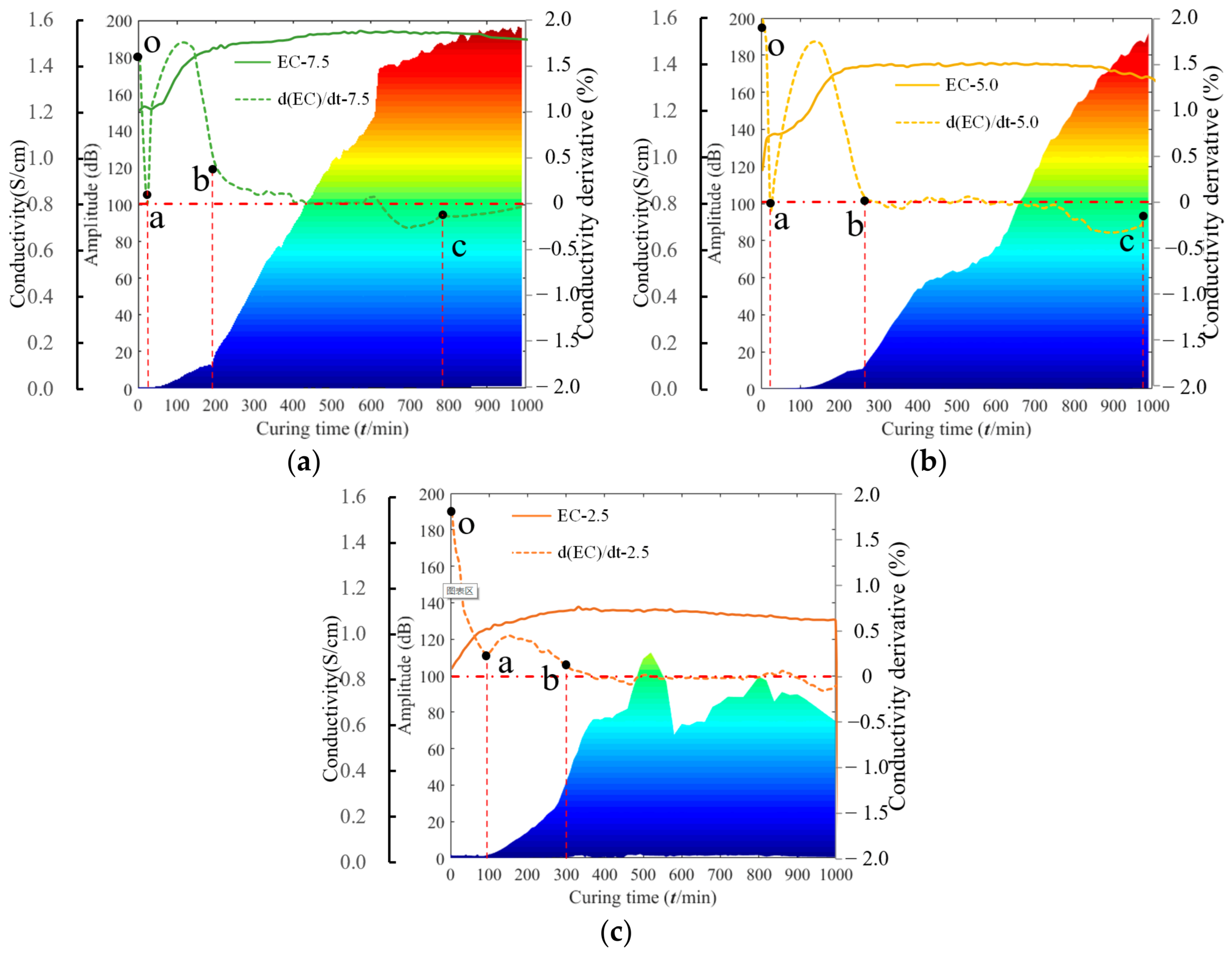

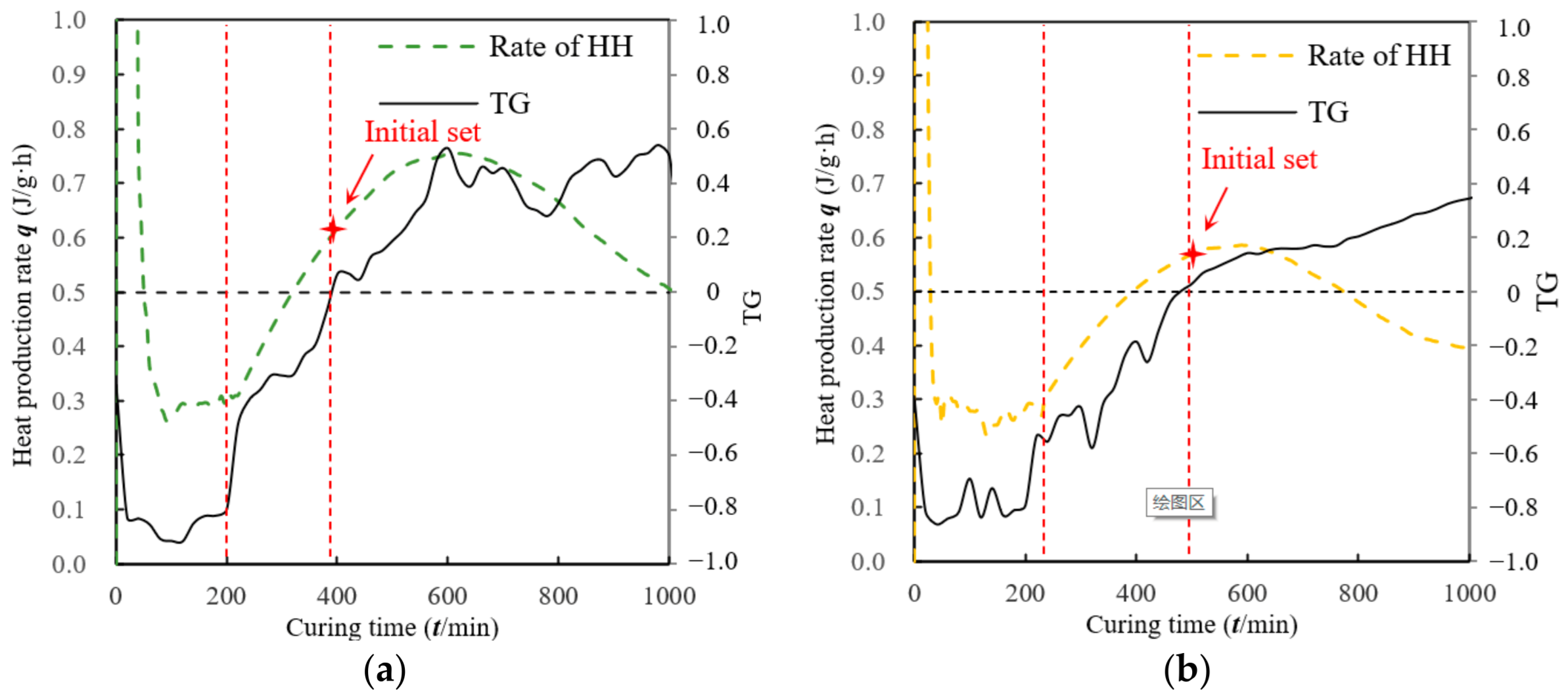

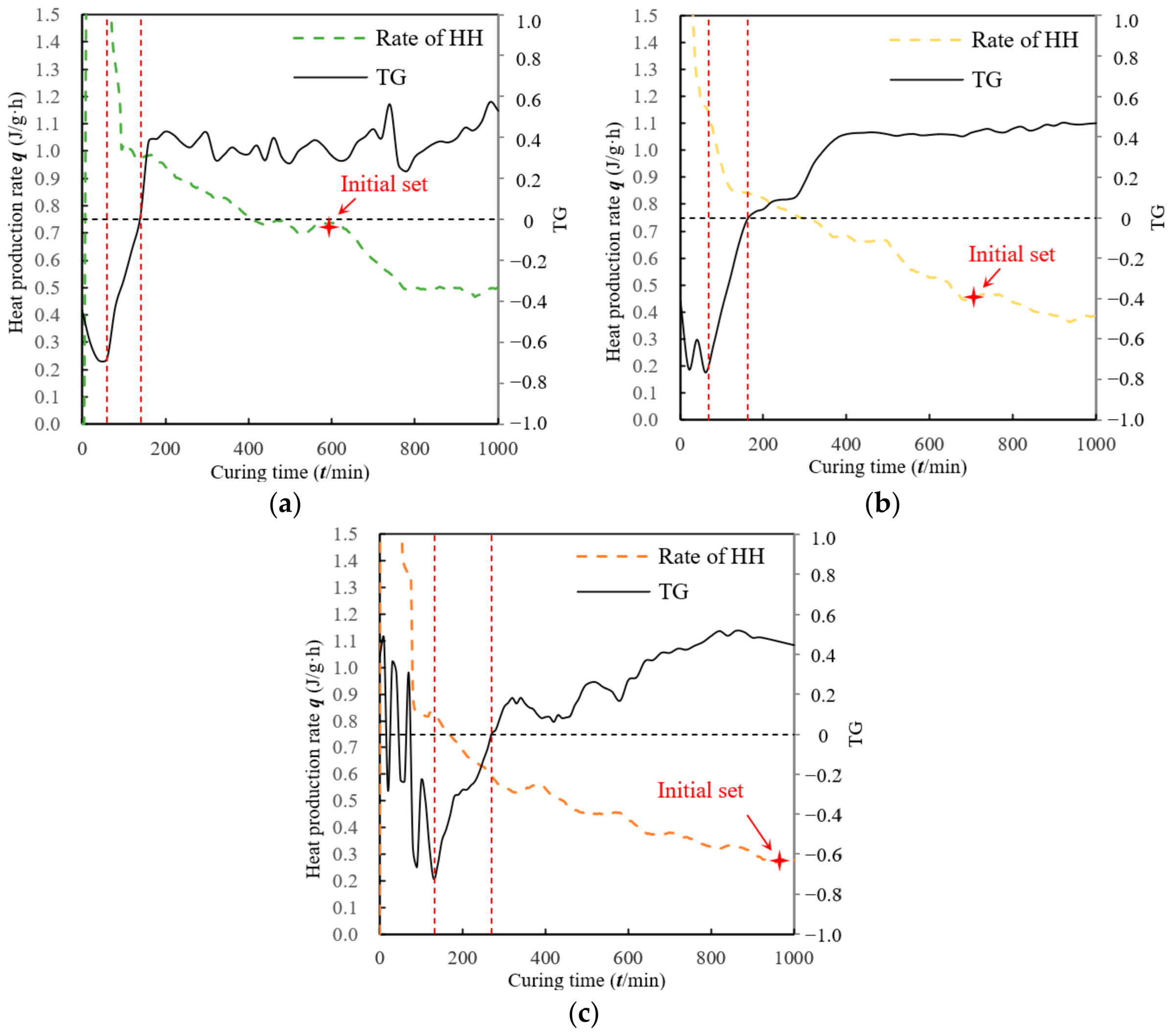



| Component | SiO2 | MgO | Fe2O3 | Al2O3 | CaO | P205 | K2O | SO3 | Others |
|---|---|---|---|---|---|---|---|---|---|
| Silica tailings (%) | 99.60 | 0 | 0 | 0 | 0 | 0 | 0 | 0 | 0.40 |
| Iron tailings (%) | 41.25 | 15.00 | 12.60 | 12.03 | 10.02 | 3.18 | 3.11 | 0.82 | 1.99 |
| Cement (%) | 20.34 | 1.09 | 3.11 | 5.02 | 64.78 | 0 | 0.10 | 2.20 | 3.36 |
| Aggregate | Cement Content (wt. %) | Solid Content (wt. %) | Water-to-Cement Ratio | Sampling Interval |
|---|---|---|---|---|
| ST, FT | 2.5, 5, 7.5 | 70 | 17, 9, 6 | 10 min |
| Aggregate | Cement (%) | Ultrasonic Pulse | Electrical Conductivity | Vicat | |||
|---|---|---|---|---|---|---|---|
| Liquid Stage | Transitional Stage | Dissolution Stage | Induction Stage | Acceleration Stage | Initial Set Time | ||
| ST | 2.5 | 280 | 490 | 40 | 480 | 660 | 503 |
| 5.0 | 260 | 390 | 50 | 390 | 620 | 475 | |
| 7.5 | 160 | 310 | 50 | 300 | 440 | 396 | |
| FT | 2.5 | 290 | 80 | 300 | 1020 | 960 | |
| 5.0 | 280 | 30 | 280 | 970 | 710 | ||
| 7.5 | 200 | 20 | 200 | 810 | 602 | ||
Disclaimer/Publisher’s Note: The statements, opinions and data contained in all publications are solely those of the individual author(s) and contributor(s) and not of MDPI and/or the editor(s). MDPI and/or the editor(s) disclaim responsibility for any injury to people or property resulting from any ideas, methods, instructions or products referred to in the content. |
© 2023 by the authors. Licensee MDPI, Basel, Switzerland. This article is an open access article distributed under the terms and conditions of the Creative Commons Attribution (CC BY) license (https://creativecommons.org/licenses/by/4.0/).
Share and Cite
Wu, W.; Xu, W.; Zhang, Y. Measuring Ultrasonic and Electrical Properties of Early-Age Cemented Tailings Backfill. Minerals 2023, 13, 135. https://doi.org/10.3390/min13020135
Wu W, Xu W, Zhang Y. Measuring Ultrasonic and Electrical Properties of Early-Age Cemented Tailings Backfill. Minerals. 2023; 13(2):135. https://doi.org/10.3390/min13020135
Chicago/Turabian StyleWu, Weilv, Wenbin Xu, and Yalun Zhang. 2023. "Measuring Ultrasonic and Electrical Properties of Early-Age Cemented Tailings Backfill" Minerals 13, no. 2: 135. https://doi.org/10.3390/min13020135





